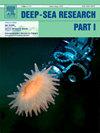地中海西北部布内斯峡谷的空中花园
IF 2.1
3区 地球科学
Q2 OCEANOGRAPHY
Deep-Sea Research Part I-Oceanographic Research Papers
Pub Date : 2025-05-08
DOI:10.1016/j.dsr.2025.104514
引用次数: 0
摘要
海底峡谷是普遍存在于大陆边缘的地貌特征。因此,它们为许多悬浮食性生物提供了适合的环境条件,因为它们在陡峭的岩石峡谷壁上定居,同时利用增加的水流带来悬浮有机物和食物。此外,海底峡谷周围的海底渔场可能会对生活在这些环境中的物种产生负面影响,包括脆弱的生态系统,如冷水珊瑚(cwc)。为了了解底栖渔业对CWC群落的影响,我们首先需要了解它们的分布、物种组成和脆弱性。Blanes峡谷是海底峡谷的一个例子,周围是海底渔场,目前缺乏对化学化学武器的基本了解。该研究通过使用沿着峡谷的ROV样带的密集网格、高分辨率测深数据和CTD测量来填补这些知识空白,这些数据共同提供了对巨型生物组合的定量描述。在450-1300米的深度范围内,Blanes峡谷至少有12种CWC,主要栖息在陡峭的峡谷壁上。发现了不同种类CWC的组合。石竹是最丰富的物种,在整个峡谷中都有发现。在峡谷头部发现了硬珊瑚种群(Desmophyllum pertusum和Madrepora oculata),而在峡谷东部分支则缺乏,主要是八珊瑚(Muriceides lepida)和黑珊瑚(Leiopathes glaberrima)。详细的CTD调查表明,在与巨石群落相同的深度范围内发现了nepheloid层(底部和中间),因为它们为悬浮饵料提供了颗粒有机质(POM)。总体而言,本研究证实了Blanes峡谷是CWC的栖息地,提供了不同巨型物种的密度和空间分布,以及它们的环境生态位信息。本文章由计算机程序翻译,如有差异,请以英文原文为准。
The hanging gardens of Blanes Canyon, Northwestern Mediterranean Sea
Submarine canyons are ubiquitous geomorphic features found intercepting the continental margins. As such, they provide environmental conditions suitable for many suspension feeding organisms, as they settle on steep rocky canyon walls, whilst taking advantage of increased currents that bring suspended organic matter and food. Additionally, demersal fishing grounds can be found surrounding submarine canyons where it can negatively affect species inhabiting these environments, including vulnerable ecosystems such as cold-water corals (CWCs). In order to understand the impacts of demersal fisheries in CWC communities, we first need to understand their distribution, species composition and vulnerability. Blanes Canyon is an example of a submarine canyon surrounded by demersal fishing grounds, where baseline knowledge on CWCs currently lacks. This study contributes to filling these knowledge gaps by using a dense grid of ROV transects along the canyon, high resolution bathymetry data and CTD surveys, which altogether provide a quantitative description of megabenthic assemblages. Blanes Canyon hosts at least 12 CWC species within 450–1300 m depth range, mainly inhabiting the steep canyon walls. Different assemblages of CWC species were found. Desmophyllum dianthus was the most abundant species, found throughout the entire canyon. Colonial scleractinian species (Desmophyllum pertusum and Madrepora oculata) were found in the canyon head but were lacking in the eastern canyon branch, where octocorals (Muriceides lepida) and black corals (Leiopathes glaberrima) were prevailing. Detailed CTD survey indicated that nepheloid layers (bottom and intermediate) were found at the same depth range as the megabenthic communities, since they provide suspension feeders with particulate organic matter (POM). Overall, this study confirms Blanes Canyon as a CWC habitat, providing densities and spatial distribution of different megabenthic species, along with information of their environmental niches.
求助全文
通过发布文献求助,成功后即可免费获取论文全文。
去求助
来源期刊
CiteScore
4.60
自引率
4.20%
发文量
144
审稿时长
18.3 weeks
期刊介绍:
Deep-Sea Research Part I: Oceanographic Research Papers is devoted to the publication of the results of original scientific research, including theoretical work of evident oceanographic applicability; and the solution of instrumental or methodological problems with evidence of successful use. The journal is distinguished by its interdisciplinary nature and its breadth, covering the geological, physical, chemical and biological aspects of the ocean and its boundaries with the sea floor and the atmosphere. In addition to regular "Research Papers" and "Instruments and Methods" papers, briefer communications may be published as "Notes". Supplemental matter, such as extensive data tables or graphs and multimedia content, may be published as electronic appendices.

 求助内容:
求助内容: 应助结果提醒方式:
应助结果提醒方式:


